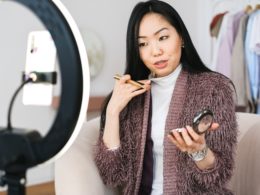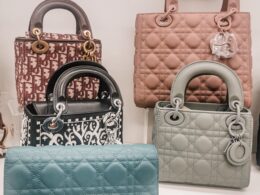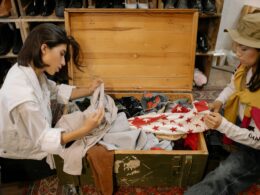Consumers shopping for luxury fashion goods–like a Prada outfit, a Louis Vuitton belt, or a Gucci handbag–may consider cost, size, visual appeal, and durability, but it is authenticity conferring a brand’s status and prestige that consumers consider most.1[1]See TFL, Authenticity – Not Originality – the Metric of Choice for Valuing Fashion?, THE FASHION LAW, (Jan. 23, 2018), https://www.thefashionlaw.com/authenticity-not-originality-the-metric-for-valuing-fashion/. Consumers clearly clamor for luxury goods, as evidenced by significant growth in the “resale apparel market,”2[2]The resale market includes consignment companies that are typically higher end outside the traditional second-hand market consisting of thrift shops. with projections that the market will grow from $15 billion in 2021 to $47 billion in 2025.3[3]See ThredUp, Resale Report 2022, ThredUp, (2022), https://www.thredup.com/resale/#whos-thrifting-and-why. These sales are facilitated by companies like TheRealReal and Vinted because of their ability to authenticate luxury products and exclude counterfeit products from the resale apparel market, with projections that the market will grow from $15 billion in 2021 to $47 billion in 2025.4[4]See id. However, traditional protection and demarcation of product authenticity, whether through legal protection or industry customs, has failed to fully address counterfeiting in fashion.5[5]See Kelly Grochala, Intellectual Property Law: Failing the Fashion Industry and Why the “Innovative Design Protection Act” Should be Passed, (2014). Student Works. 133, 1-2, https://scholarship.shu.edu/student_scholarship/133. Now, the fashion industry has turned to blockchain technology to provide consumers with an new assurance of authenticity, as seen with the creation of the Aura Blockchain Consortium.6[6]See Aura Blockchain Consortium, Authenticating Luxury Goods with Blockchain, www.aurablockchainconsortium.com (Aug. 23, 2022), https://auraluxuryblockchain.com/insight/authenticating-luxury-goods-with-blockchain.
Traditional Anti-Counterfeiting Solutions
While consumers shopping for luxury fashion goods may consider cost, size, visual appeal, and durability, they are also buying status and prestige associated with a particular brand. Whether a Prada outfit, a Louis Vuitton belt, or a Gucci handbag, it is the authenticity of these products that confers the brand’s status and prestige to the product.7[1]See TFL, Authenticity – Not Originality – the Metric of Choice for Valuing Fashion?, THE FASHION LAW, (Jan. 23, 2018), https://www.thefashionlaw.com/authenticity-not-originality-the-metric-for-valuing-fashion/. Consumers clearly clamor for luxury goods, as evidenced by significant growth in the “resale apparel market,”8[2]The resale market includes consignment companies that are typically higher end outside the traditional second-hand market consisting of thrift shops. with projections that the market will grow from $15 billion in 2021 to $47 billion in 2025.9[3]See ThredUp, Resale Report 2022, ThredUp, (2022), https://www.thredup.com/resale/#whos-thrifting-and-why. These sales are facilitated by companies like TheRealReal and Vinted because of their ability to authenticate luxury products and exclude counterfeit products from the resale apparel market.10[4]See id. However, traditional protection and demarcation of product authenticity, whether through legal protection or industry customs, has failed to fully address counterfeiting in fashion.11[5]See Kelly Grochala, Intellectual Property Law: Failing the Fashion Industry and Why the “Innovative Design Protection Act” Should be Passed, (2014). Student Works. 133, 1-2, https://scholarship.shu.edu/student_scholarship/133. Now, the fashion industry has turned to blockchain technology to provide consumers with an new assurance of authenticity, as seen with the creation of the Aura Blockchain Consortium.12[6]See Aura Blockchain Consortium, Authenticating Luxury Goods with Blockchain, www.aurablockchainconsortium.com (Aug. 23, 2022), https://auraluxuryblockchain.com/insight/authenticating-luxury-goods-with-blockchain.
Currently, the fashion industry uses limited applications of patent, copyright, and trademark law to provide piecemeal IP protection. Specifically, design patents are used to protect ornamental or decorative aspects of fashion goods, but are expensive and can take many years to acquire.13[7]John Zarocostas, The role of IP rights in the fashion business: a US perspective, WIPO MAGAZINE, (Aug. 2018) https://www.wipo.int/wipo_magazine/en/2018/04/article_0006.html. Ordinarily it is only established and prosperous brands who even contemplate pursuing a design patent.14[8]See id. Because of the difficulty involved in obtaining a design patent, most IP protection for fashion aesthetic comes under copyright law, which protects certain designs, like graphic or textile designs, located on the surface of clothing.15[9]See id. Fashion companies also seek protection under trademark law by incorporating their logo in the design, as Fendi often does, or under trade dress law, which protects the distinctive features of a clothing’s configuration, like the clothing’s overall “look and feel.”16[10]See id. Nevertheless, these forms of IP protection do not protect fashion goods in their entirety, often only protecting the aesthetic elements and not the functional elements.17[11]See Grochala supra note 5 at 2-3. Further, these forms of protection still do not act as a comprehensive solution to the thriving counterfeit luxury goods market.18[12]See Grochala supra note 5 at 2-3.
In addition to this complex and often inadequate IP protection scheme, the fashion industry developed industry custom practices to address counterfeit goods.19[13]See Id. Some of these industry custom practices add obstacles to producing a successful counterfeit product and consist of activities such as: (1) physical authentication cards; (2) physical barriers to exposure of new trends; and (3) sophistication of design and material.20[14]See Lauren Howard, An Uningenious Paradox: Intellectual Property Protections for Fashion Designs, 32 COLUM. J.L. & Arts 333, 339-40 (2008).
(1) Physical authentication cards. High-end fashion companies sometimes provide physical authentication cards for their products.21[15]See TFL, LVMH, Richemont and Prada Team Up for New Blockchain Venture Aimed at Tracing, Authenticating Luxury Goods, THE FASHION LAW, (April 21, 2021), https://www.thefashionlaw.com/lvmh-richemont-and-prada-team-up-for-new-blockchain-venture-aimed-at-tracing-authenticating-luxury-goods/. Ironically, these “authentication” cards are often faked, stolen, or lost.22[16]See Id. Moreover, these cards are not affixed to the product, meaning it can be difficult to prove which product the certificate is vouching for.23[17]See Id. Ultimately, physical authentication cards are often ineffective due to their inability to definitively assure authenticity.
(2) Physical barriers. Typically, fashion companies enjoy six months to one year of minimal to no competition before there is a consequential counterfeit presence.24[18]See Id. This is accomplished by selectively debuting collections biannually at runway presentations in New York, Milan, and Paris.25[19]See Id. By the time these collections hit the runway, high-fashion companies have already invested significant time, development, and manufacturing costs to produce the fashion line and inventory.26[20]See Id. Due to these weighty costs, counterfeiters must assess whether they want to race through a development and manufacturing process of their own to produce a counterfeit before the item goes out of style.
(3) Design and material sophistication. Designers now use more sophisticated designs, along with expensive and unique materials, to make their products difficult to replicate.27[21]See Ann Stockdale, Fresh Looks Turn Sour: Intellectual Property Protections for the Fashion World, 64 DRAKE L. REV. Discourse 1, 12 (2015). For example, designer Proenza Schouler developed a fabric for her pleated skirt that would require developing hundreds of swatches to counterfeit.28[22]See Id. When a fabric is difficult to reproduce and is essential to the piece, fewer competing counterfeit products are likely to be made.
While traditional IP protection and industry customs have attempted to protect product and brand authenticity, these solutions do not appear to be effective enough, as the counterfeit market continues to thrive.29[23]See e.g. Nick Fugallo and Paul Martinka, Cops target Canal Street counterfeits in dramatic raid, (Sep 14, 2019), https://nypost.com/2019/09/14/cops-target-canal-street-counterfeits-in-dramatic-raid/.
The Aura Blockchain Consortium: A Blockchain Anti-Counterfeiting Solution
Seeking a new and innovative approach to protect their products, luxury fashion companies have turned to blockchain technology. In September 2019, LVMH, Prada Group, and Richemont created a private blockchain called the Aura Blockchain Consortium (“Aura”).30[24]See TFL, supra note 7. Aura is a closed-system blockchain network created to protect brands from dilution and extend the consumer’s relationship with the luxury brand beyond the first sale.31[25]See Aura Blockchain Consortium, Leveraging Blockchain for Supply Chain Transparency in Luxury Sector, www.aurablockchainconsortium.com (Sep. 20, 2022), https://auraluxuryblockchain.com/insight/blockchain-for-supply-chain-transparency-luxury-sector. During production, microchips are installed within each item of apparel.32[26]See Bella Webb, Digital IDs: A game-changer for fashion?, VOGUE BUSINESS, (July 6, 2022), https://www.voguebusiness.com/companies/digital-ids-a-game-changer-for-fashion-mulberry-eon. When scanned, the consumer accesses a non-fungible token (“NFT”) of the product’s certificate of authenticity, which includes information about the clothing’s source material, styling recommendations, maintenance suggestions, and the chain of custody.33[27]See AURA BLOCKCHAIN CONSORTIUM, https://auraluxuryblockchain.com/ (last visited Oct. 6, 2022). The consortium is only as strong as its membership, which is why Aura is encouraging other brands to join the group.34[28]See id; see e.g., Dominique Muret, Mercedez-Benz joins the Aura Blockchain Consortium, FASHION NETWORK (May 22, 2022), https://ww.fashionnetwork.com/news/Mercedes-benz-joins-the-aura-blockchain-consortium,1407542.html.
Aura’s blockchain may make it easier to identify and prove infringement, as brands would simply ask for the product’s NFT for proof of authenticity. On the other hand, the scope and strength of statutory protection under design patents, copyright, trademark, and trade dress would not change. Thus, the ways in which traditional IP protection indicates and protects product authenticity will continue to be largely unaffected.
Despite the lack of change in formal IP protection, blockchain authentication has the potential to become a significant change to industry practice. First, Aura provides consumers with an easy method to police counterfeits on their own. With the ability to reliably verify the authenticity of apparel by checking an NFT certificate, consumers can actively reject fakes, thereby decreasing counterfeit sales. High-fashion companies can only do so much to remove counterfeit goods from the market, but consumer participation in this effort adds a new layer of protection.
Second, luxury fashion companies can more effectively regulate intermediaries and second-hand sellers. While companies like TheRealReal proactively authenticate apparel they resell, other significant platforms of online commerce, like Instagram and Facebook Marketplace, generally rely on consumer complaints to identify fraudulent goods offered on their marketplace.35[29]See Facebook, Good Questions, Real Answers: Protecting Brands Against Counterfeiters, www.facebook.com (Nov. 21, 2019), https://www.facebook.com/business/news/good-questions-real-answers-how-facebook-helps-brands-protect-against-counterfeits. For online marketplaces, Aura now provides a blanket authentication method that enforces a standard on all resale platforms, providing greater consumer and brand protection.
Third, luxury brands can remain aggressive in their litigation and prosecution efforts against those manufacturing and selling counterfeit goods.36[30]See Howard, supra note 6. The embedded microchip and NFT make it easier to prove product authenticity in litigation and serves as leverage in pre-lawsuit negotiations. Infringement cases should be resolved faster, allowing brands to go after more counterfeiters at lower costs per suit.
Finally, whether in Asia, Europe, or the United States, statutory IP protection and industry customs vary depending on the jurisdiction. However, Aura’s blockchain has no jurisdictional bounds.37[31]See C. Scott Hemphill & Jeannie Suk, The Law, Culture, and Economics of Fashion, STAN. L. REV. 1147, 1150 (2009). This uniform approach will be more robust as more companies join the consortium and use it in different jurisdictions.
While Aura provides an opportunity for broader protection, there are still many obstacles it faces in implementation. One major concern is consumer demand. In 2016 in the United Kingdom, nearly 60 percent of sales of counterfeit fashion and luxury-specific fakes were purchased intentionally, indicating a potential trend in which consumers seemingly may not care about whether the Gucci bag they carry is authentic or not.38[32]URWLab, Trends: the book of the second-hand apparel market, URWLAB.COM, (Sep. 2, 2021), https://urwlab.com/trends-the-boom-of-the-second-hand-apparel-market/. A second problem facing Aura is the hurdle of registering older products to the blockchain. As of June 30, 2022, over 20 brands were using Aura and over 17 million products are registered on the network, with tens of millions of other products not currently registered to Aura.39[33]See Rebecca Cairns, Crypto is crashing but the tech behind it could save luxury brands billions, CNN BUSINESS, (June 30, 2022), https://www.cnn.com/2022/06/26/business/aura-blockchain-luxury-counterfeit-hnk-spc-intl/index.html. Lastly, it is possible that additional intellectual property protections will be enacted by Congress, making Aura less necessary. There have been multiple attempts to pass legislation that would provide the fashion industry additional IP rights in the United States, but Congress has consistently rejected these proposals.40[34]See Grochala supra note 5 at 21-3. One such bill introduced in 2012, the Innovative Design Act S. 3523, aimed to provide luxury fashion designers formal intellectual property protection for both design and functional aspects of their products, but was ultimately rejected.41[35]See Id.
Written by: Joseph Bizub
Joseph is a 2024 J.D. Candidate at Brooklyn Law School
1 See TFL, Authenticity – Not Originality – the Metric of Choice for Valuing Fashion?, The Fashion Law, (Jan. 23, 2018), https://www.thefashionlaw.com/authenticity-not-originality-the-metric-for-valuing-fashion/.
2 The resale market includes consignment companies that are typically higher end outside the traditional second-hand market consisting of thrift shops.
3 See ThredUp, Resale Report 2022, ThredUp, (2022), https://www.thredup.com/resale/#whos-thrifting-and-why.
4 See id.
5 See Kelly Grochala, Intellectual Property Law: Failing the Fashion Industry and Why the “Innovative Design Protection Act” Should be Passed, (2014). Student Works. 133, 1-2, https://scholarship.shu.edu/student_scholarship/133.
6 See Aura Blockchain Consortium, Authenticating Luxury Goods with Blockchain, www.aurablockchainconsortium.com (Aug. 23, 2022), https://auraluxuryblockchain.com/insight/authenticating-luxury-goods-with-blockchain.
7 John Zarocostas, The role of IP rights in the fashion business: a US perspective, WIPO Magazine, (Aug. 2018) https://www.wipo.int/wipo_magazine/en/2018/04/article_0006.html.
8 See id.
9 See id.
10 See id.
11 See Grochala supra note 5 at 2-3.
12 See Grochala supra note 5 at 2-3.
13 See id.
14 See TFL, LVMH, Richemont and Prada Team Up for New Blockchain Venture Aimed at Tracing, Authenticating Luxury Goods, TheFashion Law, (April 21, 2021), https://www.thefashionlaw.com/lvmh-richemont-and-prada-team-up-for-new-blockchain-venture-aimed-at-tracing-authenticating-luxury-goods/.
15 See TFL, LVMH, Richemont and Prada Team Up for New Blockchain Venture Aimed at Tracing, Authenticating Luxury Goods, TheFashion Law, (April 21, 2021), https://www.thefashionlaw.com/lvmh-richemont-and-prada-team-up-for-new-blockchain-venture-aimed-at-tracing-authenticating-luxury-goods/.
16 See Howard supra note 6.
17 See id.
18 See id.
19 See id.
20 See id.
21 See Ann Stockdale, Fresh Looks Turn Sour: Intellectual Property Protections for the Fashion World, 64 Drake L. Rev. Discourse 1, 12 (2015).
22 See id.
23 See e.g. Nick Fugallo and Paul Martinka, Cops target Canal Street counterfeits in dramatic raid, (Sep 14, 2019), https://nypost.com/2019/09/14/cops-target-canal-street-counterfeits-in-dramatic-raid/.
24 See TFL, supra note 7.
25 See Aura Blockchain Consortium, Leveraging Blockchain for Supply Chain Transparency in Luxury Sector, www.aurablockchainconsortium.com (Sep. 20, 2022), https://auraluxuryblockchain.com/insight/blockchain-for-supply-chain-transparency-luxury-sector.
26 See Bella Webb, Digital IDs: A game-changer for fashion?, Vogue Business, (July 6, 2022), https://www.voguebusiness.com/companies/digital-ids-a-game-changer-for-fashion-mulberry-eon.
27 See Aura Blockchain Consortium, https://auraluxuryblockchain.com/ (last visited Oct. 6, 2022).
28 See id; see e.g., Dominique Muret, Mercedez-Benz joins the Aura Blockchain Consortium, Fashion Network (May 22, 2022), https://ww.fashionnetwork.com/news/Mercedes-benz-joins-the-aura-blockchain-consortium,1407542.html.
29 See Facebook, Good Questions, Real Answers: Protecting Brands Against Counterfeiters, www.facebook.com (Nov. 21, 2019), https://www.facebook.com/business/news/good-questions-real-answers-how-facebook-helps-brands-protect-against-counterfeits.
30 See Howard, supra note 6.
31 See C. Scott Hemphill & Jeannie Suk, The Law, Culture, and Economics of Fashion, Stan. L. Rev. 1147, 1150 (2009).
32 URWLab, Trends: the book of the second-hand apparel market, URWLab.com, (Sep. 2, 2021), https://urwlab.com/trends-the-boom-of-the-second-hand-apparel-market/.
33 See Rebecca Cairns, Crypto is crashing but the tech behind it could save luxury brands billions, CNN Business, (June 30, 2022), https://www.cnn.com/2022/06/26/business/aura-blockchain-luxury-counterfeit-hnk-spc-intl/index.html.
34 See Grochala supra note 5 at 21-3.
35 See id.




